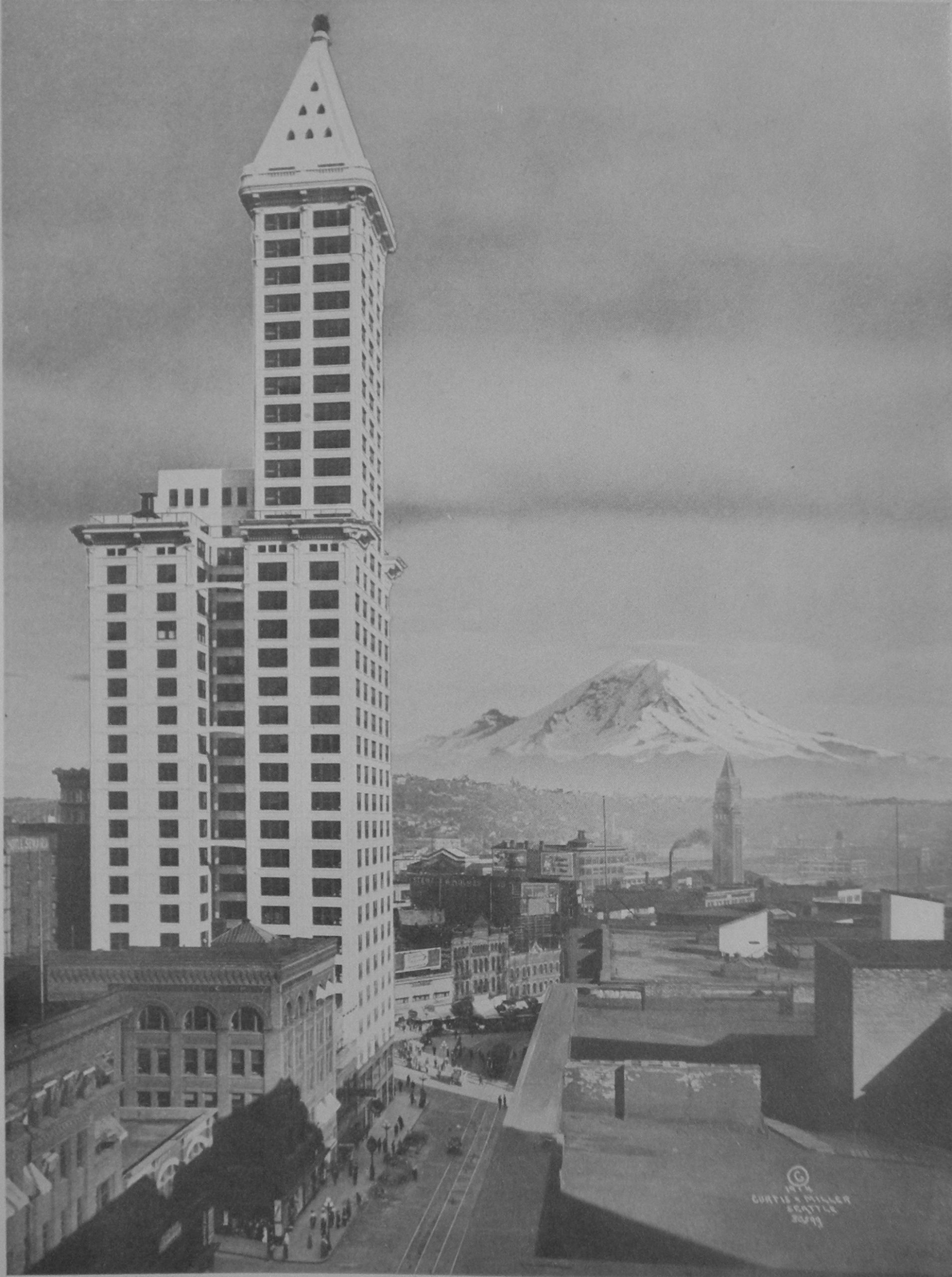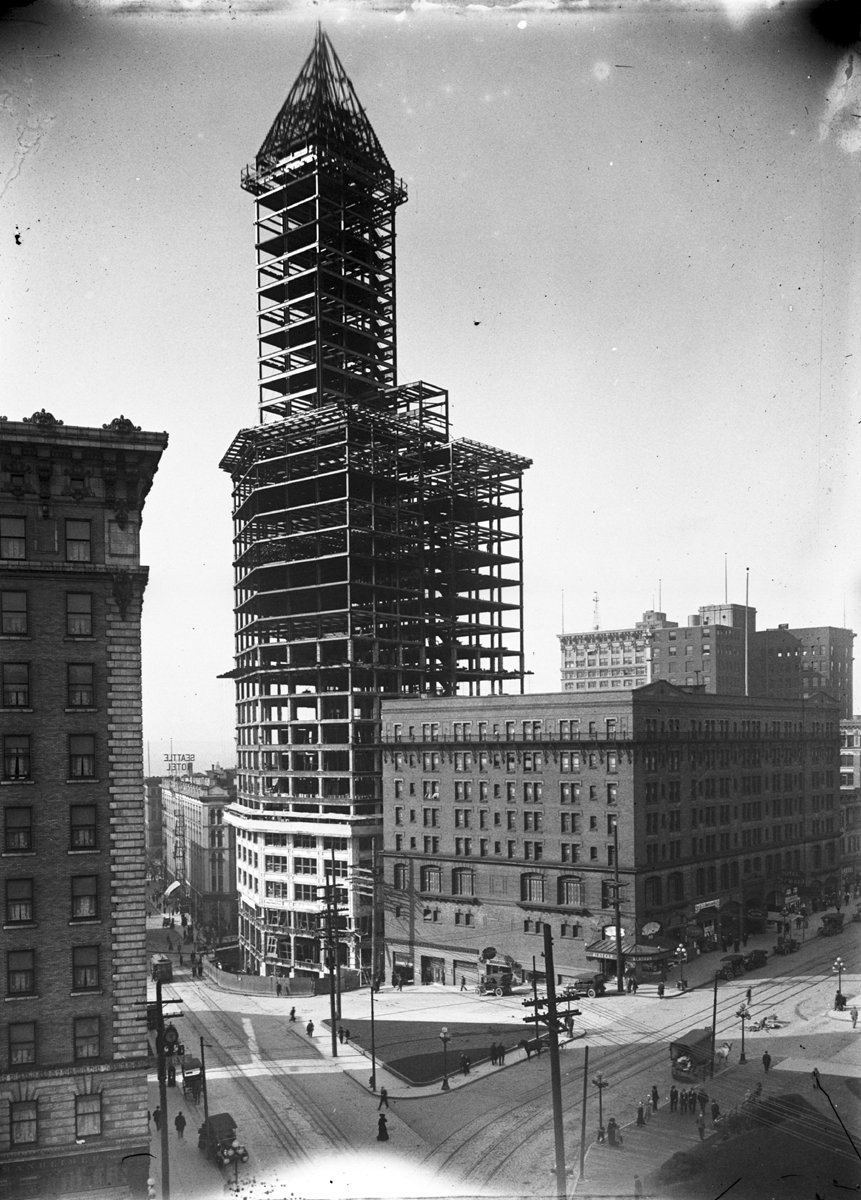
HISTORY OF SEATTLE From the Earliest Settlement to the Present Time
Author, Clarence B. Bagley. (Clarity edits and updates by OHA.)
CHICAGO THE SJ CLARKE PUBLISHING COMPANY, 1916
You can read more about Seattle’s Smith Tower via the Seattle Times.
“One of Seattle’s most unique structures is the forty two story LC Smith Building, which was the result of a non resident’s faith in the future of the city. The chain of circumstances that led up to the construction of the conspicuous landmark starts away back, about a full half century ago. At that time, Miss Mary Slocum was making dresses for Mrs. LC Smith’s mother and other women in Syracuse. N.Y. In the 1880s Miss Slocum decided to join her sister Mrs. WE Boone in Seattle. In 1888 Mrs. Smith’s parents Mrs Smith and her son Burns Lyman Smith crossed the continent for a visit to San Francisco. While on the coast they decided that they had better return home by way of Seattle in order to see their old friend Miss Slocum.
The most notable incident of the visit being the soaking of Mr. Boone by little Burns, who learned to play with the garden hose and who was promptly chastised by his victim. On the return home, the members of the party were warm in their praise of Seattle and Mr. Smith visited the city a few years later in order to see it for himself. In 1890, JW Clise left for New York City to endeavor to interest capital in the purchase of a number of properties in the wholesale district south of Yesler Way. He stopped off at Syracuse to call on his friend William Nottingham, a prominent attorney. In the course of the visit, Mr Nottingham suggested that he try to interest LC Smith in the properties. Mr. Smith by that time had amassed a great fortune in the manufacture of the typewriter that bears his name. The necessary introduction was arranged and the three men held numerous conferences. A few months later, Mr. Smith wrote one check to cover the purchase of the following properties: The northeast corner of Second Avenue and Yesler Way, where the great building now stands, the Pacific Block, the northwest corner of Occidental, the Grand Central Hotel Building at the northeast corner of First and Main, and the northwest corner of First and King Four and five story modern buildings occupied some of the corners. Watson C Squire, formerly governor of Washington, was the vendor. It was probably the largest individual purchase of property at any one time in the history of Seattle real estate.
 It was two years since he made the deal before Mr. Smith came west again to view his property. Meanwhile, Mr. Clise represented him here and continued to do so for ten years. In 1909, Mr. Smith visited Seattle and Mr. Clise urged him to improve his property at Second and Yesler as the chief building, then under way in the city, was in the neighborhood of Second and Pike and Mr Clise feared that the other end of Second Avenue was suffering from neglect. While in Seattle, Mr. Smith met John Hoge, who was associated with James D Hoge in the ownership of northwestern corner of Second and Cherry and the two millionaires in a good natured sparring regarding the improvement of their respective. Each was anxious to build a greater structure than the other and declared that they thought fourteen stories was about the proper height. Meanwhile, Burns Lyman Smith was busy examining sky scrapers in New York and, when his father returned East in November 1909, the son was wedded to the idea of erecting a main building twenty one stories high and a tower of same height above it making forty two stories in all. Both of them were somewhat surprised when Mr. Smith, on the night of his return, stated that he thought he had better run up building so high that there was no danger of anyone else even approaching for many years to come and outlined just the sort of structure that his and son had intended him to build. Gaggin & Gaggin Syracuse were called in work started November 1, 1911 and in 1914 the building was opened. Mr Smith never lived to see his plans materialize, though Burns Lyman Smith carried them through.”
It was two years since he made the deal before Mr. Smith came west again to view his property. Meanwhile, Mr. Clise represented him here and continued to do so for ten years. In 1909, Mr. Smith visited Seattle and Mr. Clise urged him to improve his property at Second and Yesler as the chief building, then under way in the city, was in the neighborhood of Second and Pike and Mr Clise feared that the other end of Second Avenue was suffering from neglect. While in Seattle, Mr. Smith met John Hoge, who was associated with James D Hoge in the ownership of northwestern corner of Second and Cherry and the two millionaires in a good natured sparring regarding the improvement of their respective. Each was anxious to build a greater structure than the other and declared that they thought fourteen stories was about the proper height. Meanwhile, Burns Lyman Smith was busy examining sky scrapers in New York and, when his father returned East in November 1909, the son was wedded to the idea of erecting a main building twenty one stories high and a tower of same height above it making forty two stories in all. Both of them were somewhat surprised when Mr. Smith, on the night of his return, stated that he thought he had better run up building so high that there was no danger of anyone else even approaching for many years to come and outlined just the sort of structure that his and son had intended him to build. Gaggin & Gaggin Syracuse were called in work started November 1, 1911 and in 1914 the building was opened. Mr Smith never lived to see his plans materialize, though Burns Lyman Smith carried them through.”

